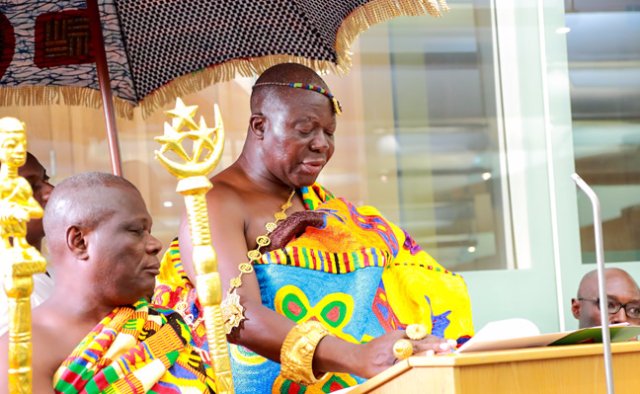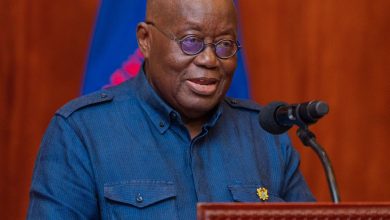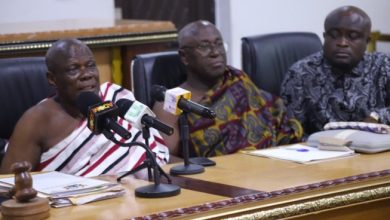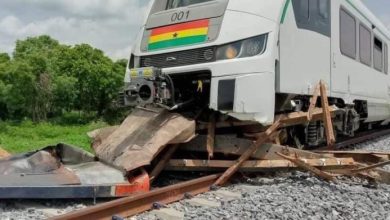What the Asantehene said in reply to Dormaahene’s recent historical narratives

What the Asantehene Otumfuo Osei Tutu II said in relation to recent historical narratives by the Dormaahene, Oseadeyo Agyeman Badu II, and the paying of allegiance to Asanteman and the Golden Stool by various chiefs in Bono East, Bono and Ahafo Regions has been published in the video below.
The Asantehene speaking at the first Asanteman Council meeting for 2022 in Kumasi also gave hints of plans to elevate some chiefs and towns to the status of paramount chiefs in Bono East, Bono and Ahafo Regions.
He, has, subsequently charged the Mamponghene and occupant of the Silver Stool, Daasebre Osei Bonsu II to spearhead the reconstitution of the various standing committees for Asanteman and consider the newly created regions and how towns and chiefs deserving elevation would be granted that status for representation at the various Regional House of Chiefs.
The Asantehene spoke in the Twi language at the meeting which was held at the Manhyia Palace
Otumfuo Osei Tutu II said the political regional demarcations for political administration by the central government does not necessarily mean that chiefs located in different regions will no longer pay allegiance to Asanteman and the Golden Stool, neither will Asanteman force or coerce any chief to pay allegiance.
He said his intention was to give a facelift to those willing to work under the Asanteman umbrella and there were no plans to enslave anyone.
He said chiefs willing to continue to pay allegiance to Asanteman and gain the needed development and progress in their respective areas should not be discouraged by other chiefs who have no impact on them.
He said the then Dormaahene, Agyeman Badu for instance, paid allegiance to his uncle, the then Asantehene, Nana Kwame Kyeretwie before he became chief of Dormaa while he was still a teacher at the Government Boys School in Kumasi and that it was only recently that the Dormaahene, has decided not to pay allegiance to the Golden Stool and Asanteman.
But even with that, no one will attempt to coerce the Dormaahene to do so.
That, should however, not mean that there should be an attempt to change historical narrative.
That, should not also mean that other chiefs in the Bono, Bono East and Ahafo areas wanting to continue to pay allegiance to the Golden Stool and Asanteman should be disturbed in anyway.
The Asantehene said that is why plans were underway to elevate such chiefs to the status of paramount chiefs.
Otumfuo Osei Tutu II said he will not engage in unnecessary debates and that all towns in Bono, Bono East and Ahafo regions deserving elevation will be granted that status.
He mentioned that Mo, Banda, Bomaa all pay allegiance to the Golden Stool.
He said there were enough paramount chiefs paying allegiance to the Golden Stool and that if Dormaa decides not to pay allegiance, the chief will not be coerced in anyway.
What the Dormaahene Oseadeeyo Agyemang Badu II said
The Dormaahene, Oseadeeyo Agyemang Badu II, had recently stated that history had been distorted by the Asante’s to suit their interest.
He said, some chiefs in Ghana talk as if they are greater
than the Almighty God but said nobody was greater than God.
Going into history and in an attempt to narrate and explain how Asanteman became populous and bigger, Oseadeeyo Agyemang Badu II said, in the year 1640, the then chief of Akwamu, Ansa Sasraku, was going about saying when he die, none of the twins of his sister can succeed him; this continued for a while till he died and it resulted in a confusion.
The Dormaahene said, amid the confusion, the people of Kumawu took over some territories and even extended to Côte d’lvoire but when they got to
present-day Asante, that territory was under the
Denkyirahene.
Today they [Asantes] have an appellation as “Asante Kotoko, kum apem a apem beba’ [if you kill thousand, a thousand more will come] but do you know that of the people of Bono, theirs is ‘abono kyen apem’ [Bonos are more than thousand]”, he said.
Oseadeeyo Agyemang Badu Il said when they got to Denkyira, Dormaahene had his territory; so the two were not fighting each other, and that their brothers from Asante – were a group of people who had come together – but they broke away from Ntim Gyakari and decided to fight the people of Dormaa because they had been defeated six times.
He said the people of Dormaa beheaded the chief of the Asantes and his head is still with the people of Dormaa and that it took the people of Dormaa 250 years before they settled at Dormaa Ahenkro but no chief was able to defeat the chief of Dormaa.
Talking about the story and the history that two trees were planted in Kumasi and Kumawu and because the tree in Kumawu did not survive and that is why the place is called Kumawu; the Dormaa said that is a lie.
When we talk about Kumasi, it means that they
were labourers. When we got to the place known as
Asante today, the people of Kumasi were under Denkyira and they were responsible for getting the Denkyirahene firewood that is ‘akuma ase’ but today, because of their population, they have changed it, he said.
It means ‘akuma ase hene’ and not Kum. If you are a chief and you are brilliant and you know the law, people are afraid of you, the Dormaahene said.





